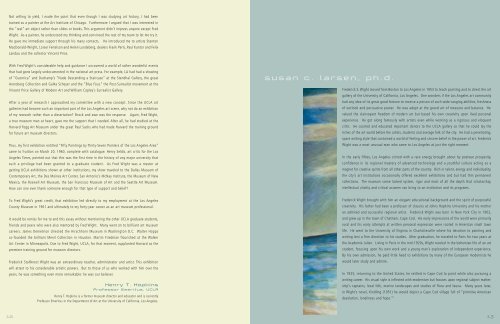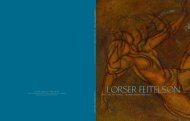louis stern fine arts visions of california
louis stern fine arts visions of california
louis stern fine arts visions of california
You also want an ePaper? Increase the reach of your titles
YUMPU automatically turns print PDFs into web optimized ePapers that Google loves.
Not willing to yield, I made the point that even though I was studying art history, I had been<br />
trained as a painter at the Art Institute <strong>of</strong> Chicago. Furthermore I argued that I was interested in<br />
the “real” art object rather than slides or books. This argument didn’t impress anyone except Fred<br />
Wight. As a painter, he understood my thinking and.convinced the rest <strong>of</strong> my team to let me try it.<br />
He gave me immediate support through his many contacts. He introduced me to artists Stanton<br />
MacDonald-Wright, Lorser Feitelson and Helen Lundeberg, dealers Frank Perls, Paul Kantor and Felix<br />
Landau and the collector Vincent Price.<br />
With Fred Wight’s considerable help and guidance I uncovered a world <strong>of</strong> rather wonderful events<br />
that had gone largely undocumented in the national art press. For example, LA had had a showing<br />
<strong>of</strong> “Guernica” and Duchamp’s “Nude Descending a Staircase” at the Stendhal Gallery, the great<br />
Arensberg Collection and Galka Scheyer and the “Blue Four,” the Post-Surrealist movement at the<br />
Vincent Price Gallery <strong>of</strong> Modern Art and William Copley’s Surrealist Gallery.<br />
After a year <strong>of</strong> research I approached my committee with a new concept. Since the UCLA art<br />
galleries had become such an important part <strong>of</strong> the Los Angeles art scene, why not do an exhibition<br />
<strong>of</strong> my research rather than a dissertation? Shock and awe was the response. Again, Fred Wight,<br />
a true museum man at heart, gave me the support that I needed. After all, he had studied at the<br />
Harvard Fogg Art Museum under the great Paul Sachs who had made Harvard the training ground<br />
for future art museum directors.<br />
Thus, my first exhibition entitled “Fifty Paintings by Thirty-Seven Painters <strong>of</strong> the Los Angeles Area”<br />
came to fruition on March 20, 1960, complete with catalogue. Henry Seldis, art critic for the Los<br />
Angeles Times, pointed out that this was the first time in the history <strong>of</strong> any major university that<br />
such a privilege had been granted to a graduate student. As Fred Wight was a master at<br />
getting UCLA exhibitions shown at other institutions, my show traveled to the Dallas Musuem <strong>of</strong><br />
Contemporary Art, the Des Moines Art Center, San Antonio’s McNay Institute, the Museum <strong>of</strong> New<br />
Mexico, the Roswell Art Museum, the San Francisco Museum <strong>of</strong> Art and the Seattle Art Museum.<br />
How can one ever thank someone enough for that type <strong>of</strong> support and belief?<br />
To Fred Wight’s great credit, that exhibition led directly to my employment at the Los Angeles<br />
County Museum in 1961 and ultimately to my forty-year career as an art museum pr<strong>of</strong>essional.<br />
It would be remiss for me to end this essay without mentioning the other UCLA graduate students,<br />
friends and peers who were also mentored by Fred Wight. Many went on to brilliant art museum<br />
careers. James Demetrion directed the Hirschhorn Museum in Washington D.C. Walter Hopps<br />
co-founded the brilliant Menil Collection in Houston. Martin Friedman flourished at the Walker<br />
Art Center in Minneapolis. Due to Fred Wight, UCLA, for that moment, supplanted Harvard as the<br />
premiere training ground for museum directors.<br />
Frederick Stallknect Wight was an extraordinary teacher, administrator and artist. This exhibition<br />
will attest to his considerable artistic powers. But to those <strong>of</strong> us who worked with him over the<br />
years, he was something even more remarkable: he was our believer.<br />
12<br />
H e n r y T . H o p k i n s<br />
P ro fe s s o r E m e r i t u s , U C L A<br />
Henry T. Hopkins is a former museum director and educator and is currently<br />
Pr<strong>of</strong>essor Emeritus in the Department <strong>of</strong> Art at the University <strong>of</strong> California, Los Angeles.<br />
s u s a n c . l a r s e n , p h . d .<br />
Frederick S. Wight moved from Boston to Los Angeles in 1953 to teach painting and to direct the art<br />
gallery <strong>of</strong> the University <strong>of</strong> California, Los Angeles. One wonders if the Los Angeles art community<br />
had any idea <strong>of</strong> its great good fortune to receive a person <strong>of</strong> such wide-ranging abilities, freshness<br />
<strong>of</strong> outlook and persuasive power. He was adept at the grand art <strong>of</strong> measure and balance. He<br />
valued the clairvoyant freedom <strong>of</strong> modern art but based his own creativity upon lived personal<br />
experience. He got along famously with artists even while working as a rigorous and eloquent<br />
critic. He courted and educated important donors to the UCLA gallery so that he could lay the<br />
riches <strong>of</strong> the art world before the artists, students and average folk <strong>of</strong> the city. He had a penetrating,<br />
spare writing style that contained a world <strong>of</strong> feeling and sincere belief in the power <strong>of</strong> art. Frederick<br />
Wight was a most unusual man who came to Los Angeles at just the right moment.<br />
In the early fifties, Los Angeles stirred with a rare energy brought about by postwar prosperity,<br />
confidence in its regional mastery <strong>of</strong> advanced technology and a youthful culture acting as a<br />
magnet for creative spirits from all other p<strong>arts</strong> <strong>of</strong> the country. Rich in talent, energy and individuality,<br />
the city’s art institutions occasionally <strong>of</strong>fered excellent exhibitions and but had thin permanent<br />
collections. The museum scene lacked system, rigor and most <strong>of</strong> all the depth that scholarship,<br />
intellectual vitality and critical acumen can bring to an institution and its programs.<br />
Frederick Wight brought with him an elegant educational background and the spirit <strong>of</strong> purposeful<br />
creativity. His father had been a pr<strong>of</strong>essor <strong>of</strong> classics at Johns Hopkins University and his mother<br />
an admired and successful regional artist. Frederick Wight was born in New York City in 1902,<br />
and grew up in the town <strong>of</strong> Chatham, Cape Cod. His early impressions <strong>of</strong> the world were primarily<br />
rural and his early attempts at written personal expression were rooted in American small town<br />
life. He went to the University <strong>of</strong> Virginia in Charlottesville where his devotion to painting and<br />
writing lent a firm direction to his studies. After graduation, he traveled to Paris for two years at<br />
the Academie Julien. Living in Paris in the mid-1920s, Wight reveled in the bohemian life <strong>of</strong> an art<br />
student, focusing upon his own work and a young man’s exploration <strong>of</strong> independent experience.<br />
By his own admission, he paid little heed to exhibitions by many <strong>of</strong> the European modernists he<br />
would later study and admire.<br />
In 1925, returning to the United States, he settled in Cape Cod to paint while also pursuing a<br />
writing career. His visual style is inflected with modernism but focuses upon regional subject matter:<br />
ship’s captains, local folk, marine landscapes and studies <strong>of</strong> flora and fauna. Many years later,<br />
in Wight’s novel, Kindling (1951) he would depict a Cape Cod village full <strong>of</strong> “primitive American<br />
desolation, loneliness and hope.” 1<br />
13





